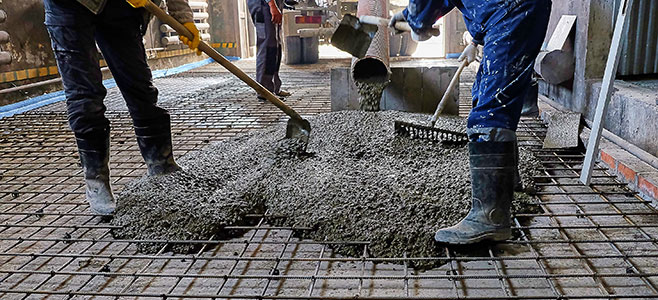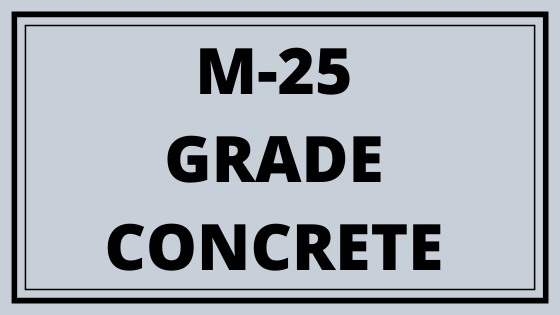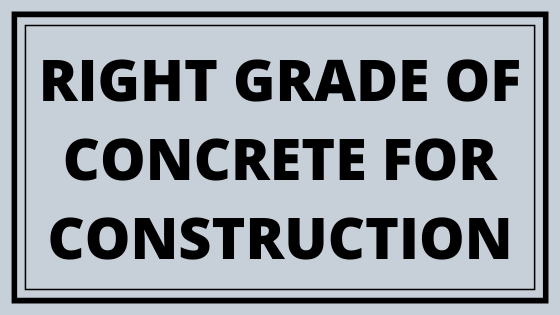What Is Concrete?
Important Point
Contrary to popular belief, concrete and cement are not the same; cement is really just one component of concrete.
Concrete consists of three basic components: water, aggregate (rock, sand or gravel), and Portland cement. Cement, usually in powder form, acts as a binding agent when mixed with water and aggregates.
This combination, or concrete mix, will be poured and hardened into the durable material with which we are all familiar.
Concrete is a composite mixture consisting of cement, sand, and aggregate. The design of the concrete mix is a procedure to find the correct quantities of these materials to achieve the desired strength.
The precise design of the concrete mix makes concrete construction economical.
Large buildings, such as bridges and dams, require an enormous amount of concrete, and the right amount of constituents makes the structure economical.
To calculate or find the right amount of cement, sand, and aggregate needed in 1m3 of concrete, you need to know different degrees of concrete.
Different grades of concrete are gradeified into M5, M7.5, M10, M15, etc., while M stands for Mix, and the number behind M stands for characteristic compressive strength (fck) of concrete in N / mm2 at 28 days when verified with 15 cm x 15 cm x 15 cm cube in a direct compression test.
Also, read: What Is DLC (Dry Lean Concrete) | Advantge of DLC (Dry Lean Concrete )
Understanding Concrete Grades
The concrete grades are defined by the strength and composition of the concrete and the minimum strength that the concrete must have after 28 days of the initial construction.
The degree of concrete is understood in the measurements of MPa, where M means mixture, and MPa indicates the general strength.
Concrete mixtures are defined in ascending numbers of 5, starting at 10, and show the compressive strength of concrete after 28 days.
For example,
C10 has a force of 10 newtons, C15 has a force of 15 newtons, C20 has a force of 20 newtons, and so on.
Different mixtures (M) occur in various mixing ratios of the various cement, sand, and coarse aggregate ingredients.
For example,
M20 comes in the respective 1: 1: 5: 3 ratio. You can see other examples below in the table.
Also, read: How to Calculate Staircase | Concrete & Bar Bending Schedule (BBS)
What Is the Difference Between M25 and M30?
To differentiate the two, we have to elaborate them first;
What Is M25 Grade?
It is a grade of concrete that would achieve a compressive strength of 25 N / mm2 after 28 days of curing.
It is made by mixing cement, fine aggregates and coarse aggregates in a 1: 1: 2 ratio, keeping the water-cement ratio between 0.4 and 0.6.
M25 Concrete Means
In this designation, the letter M refers to the mix and the number to the specified 28-day cube strength of mix in N/mm2. The mixes of grades M25 correspond approximately to the mix proportions (1:1:2) respectively.
What Is M30 Grade?
M30 represents the concrete mixture that, after 28 days of curing, will give a resistance of 30 N / mm2.
At my site, for building construction, the M30 Concrete is being used. The proportion of ingredients is as follows for the concrete mix M30 (In liters): – CEMENT – 35 It.
Fine aggregates and coarse aggregates in a 1: 0.75: 1.5 ratio, keeping the water-cement ratio between 0.4 and 0.6.
Also, read: What Is Bulkage of Sand (Fine Aggregate )
Methods to Differentiate M25 and M30
There are a few methods to find the difference in M25 and M30.
Method 1: Perform the crush resistance test in the laboratory. The test takes 28 days but provides promising results (use 3 samples each to ensure 100% safety).
Method 2: The C: S: A ratio of both is different. This should help.
Method 3: Take a sample of each in a container/cistern (of equal volume) and fill them The CSA ratio of the M25 is 1: 1: 2, while that of the M30 is mix design (but is generally greater than M25).
As the weight of the aggregate is dominating the mixture, the weight of the M30 sample will be greater. Thus, we can differentiate between samples.
Other ways:
You can do a compressive strength test (done by crushing the cubes), which is highly reliable, but it takes 28 days to get the results or opt for an accelerated cure test, which provides an approximate value of the compressive strength of the cubes in one day.
In a compressive strength test, a molten concrete cube is immersed in water for 28 days under normal atmospheric conditions.
After 28 days, the cubes are removed, dried for an hour or two so that they do not get wet, and then a crush resistance test is performed.
Three similar cubes are tested, and the result for the M25 will be close to 25 N / mm2; similarly, for the M30, the resistance will be close to 30 N / mm2.
When it comes to accelerated cure tests, the most commonly used curing techniques are steam curing under atmospheric pressure, hot water curing, boiling water curing, and autoclaving.
Theoretically, you can know if it is M25 or M30 if you know the composition of Cement: Sand: Add to the mixture.
If you want to know about it after molding concrete into structural elements, the Rebound Hammer test can be used.
It is a non-destructive test. Using a conversion graph, we can calculate the compressive strength of the structural member.
Also, read: Cinder Block Vs Concrete Block | What Is Cinder Blocks | What Is Concrete Blocks
How to Select the Right Grade of Concrete for Construction?
The degree of construction of the concrete is selected based on the structural design requirements. There are two types of concrete mixes, nominal mix, and design mix.
Nominal mix concrete is that generally used for small-scale construction and small residential buildings where the consumption of concrete is not high.
The nominal mixture takes care of the safety factor against several quality control problems that usually occur during the construction of the concrete.
Design mixing concrete is one for which mixing rates are obtained in various laboratory tests. The use of shotcrete requires good quality control during the selection, mixing, transportation, and placement of the concrete.
This concrete offers mixed proportions based on the material available locally and offers savings in construction if large-scale concrete construction is carried out. Thus, large concrete construction projects use concrete mix design.
Therefore, an appropriate grade of concrete can be selected based on structural requirements. Nominal mixtures for concrete types such as M15, M20, M25 are generally used for small-scale construction.
Large structures have high strength requirements and are therefore used for higher grades of concrete, such as M30 and above. The mixing proportions of these concretes are based on the design of the mix.
Different Mix Ratio As Below
| Concrete Grade | Mix Ratio (Cement: Sand: Aggregates) | Compressive Strength | |
| MPa (N/mm2) | Psi | ||
| Grades of Concrete | |||
| M5 | 1 : 5 : 10 | 5 MPa | 725 psi |
| M7.5 | 1 : 4 : 8 | 7.5 MPa | 1087 psi |
| M10 | 1 : 3 : 6 | 10 MPa | 1450 psi |
| M15 | 1 : 2 : 4 | 15 MPa | 2175 psi |
| M20 | 1 : 1.5 : 3 | 20 MPa | 2900 psi |
| Standard Grade of Concrete | |||
| M25 | 1 : 1 : 2 | 25 MPa | 3625 psi |
| M30 | Design Mix | 30 MPa | 4350 psi |
| M35 | Design Mix | 35 MPa | 5075 psi |
| M40 | Design Mix | 40 MPa | 5800 psi |
| M45 | Design Mix | 45 MPa | 6525 psi |
| High Strength Concrete Grades | |||
| M50 | Design Mix | 50 MPa | 7250 psi |
| M55 | Design Mix | 55 MPa | 7975 psi |
| M60 | Design Mix | 60 MPa | 8700 psi |
| M65 | Design Mix | 65 MPa | 9425 psi |
| M70 | Design Mix | 70 MPa | 10150 psi |
Like this post? Share it with your friends!
Suggested Read –
- What Is Honeycomb In Concrete | Cause | Cure | Type of Grouting
- Why Is Polymer Mortar/Concrete | Type of Polymer Mortar/Concrete
- What Is DLC (Dry Lean Concrete) | Advantge of DLC (Dry Lean Concrete )
- What Is Slump Cone Test | Principle of Slump Test | Types of Concrete Slump
- What Is Workability of Concrete | Factors Affecting Workability | Test |Errors
Originally posted 2020-05-15 10:59:02.







Leave a Reply